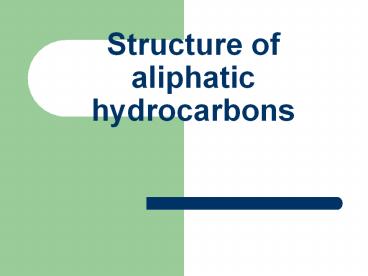Structure of aliphatic hydrocarbons - PowerPoint PPT Presentation
1 / 28
Title:
Structure of aliphatic hydrocarbons
Description:
... a cyclic aliphatic hydrocarbon Homologous series A homologous series is a family of organic compounds with the same general formula, similar chemical ... – PowerPoint PPT presentation
Number of Views:1379
Avg rating:3.0/5.0
Title: Structure of aliphatic hydrocarbons
1
Structure of aliphatic hydrocarbons
2
Aliphatic hydrocarbons
- Aliphatic hydrocarbons are hydrocarbons that
consist of straight or branched chains of carbon
atoms, or rings of carbon atoms other than those
containing a special ring called a benzene ring
3
Pentane a straight chain aliphatic hydrocarbon
4
A branched chain hydrocarbon
5
Cyclohexane a cyclic aliphatic hydrocarbon
6
Homologous series
- A homologous series is a family of organic
compounds with the same general formula, similar
chemical properties, and successive members
differing by CH2 - Alkanes, alkenes and alkynes are three different
homologous series of aliphatic hydrocarbons
7
Alkanes
- Alkanes are a homologous series of hydrocarbons
with the general formula CnH2n2 - They are named systematically, with a prefix
indicating the number of carbon atoms per
molecule, and the ending ane
8
Alkanes
- Methane CH4
- Ethane C2H6
- Propane C3H8
- Butane C4H10
- Pentane C5H12
- Hexane C6H14
- Heptane C7H16
- Octane C8H18
9
Alkanes
- Alkane molecules are tetrahedral, e.g. propane
10
Structural formulas
- The structural formula of an alkane indicates the
way atoms in a molecule of the alkane are bonded
together - The following slides show the structural formulas
of some of the alkanes
11
Methane
12
Ethane
13
Propane
14
Butane
15
Pentane
16
Structural isomers
- Structural isomers are compounds that have the
same molecular formula but different structural
formulas - Butane (C4H10)is the simplest alkane which has
structural isomers, called butane and
2-methylpropane respectively - The name 2-methylpropane indicates that there is
a methyl (CH3) group attached instead of one of
the hydrogen atoms to the second carbon in propane
17
Isomers of butane
18
An isomer of octane (C8H18)
- 2,2,4-trimethylpentane is so called because there
are two methyl groups attached (in place of
hydrogen atoms) to the second carbon atom and one
(in place of another hydrogen atom) to the fourth
carbon atom in a pentane molecule
19
Physical properties of alkanes
- Physical state The first four alkanes are gases,
while pentane and higher alkanes are liquids - Insoluble in water
- Soluble in non-polar solvents such as cyclohexane
20
Alkenes
- Alkenes are a homologous series of hydrocarbons
with the general formula CnH2n - They are named systematically, with a prefix
indicating the number of carbon atoms per
molecule, and the ending ene
21
Alkenes
- Ethene C2H4
- Propene C3H6
- But-1-ene C4H8
- But-2-ene C4H8
22
Ethene
23
Propene
24
But-1-ene
25
But-2-ene
26
Physical properties of alkenes
- Physical state Gases
- Insoluble in water
- Soluble in non-polar solvents such as cyclohexane
27
Alkynes
- Alkynes are a homologous series of hydrocarbons
with the general formula CnH2n-2 - Ethyne (C2H2) is the first member of the series
28
Physical properties of ethyne
- Physical state Gas
- Insoluble in water
- Soluble in non-polar solvents such as cyclohexane

